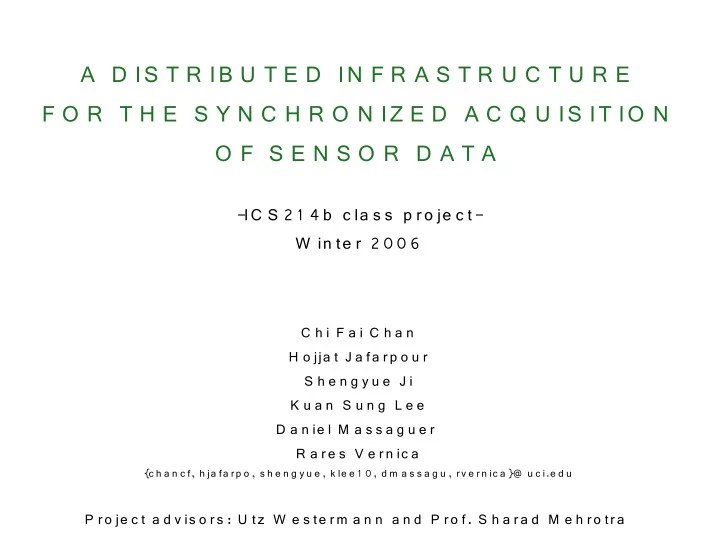

A D IS T R IB U T E D IN F R A S T R U C T U R E F O R T H E S Y N C H R O N IZ E D A C Q U IS IT IO N O F S E N S O R D A T A -IC S 21 4b c la s s p ro je c t- W in te r 2006 C h i F a i C h a n H o jja t J a fa rp o u r S h e n g y u e J i K u a n S u n g L e e D a n ie l M a s s a g u e r R a re s V e rn ic a {c h a n c f, h ja fa rp o , s h e n g y u e , k le e 1 0, d m a s s a g u , rv e rn ic a }@ u c i.e d u P ro je c t a d v is o rs : U tz W e s te rm a n n a n d P ro f. S h a ra d M e h ro tra
RES PONS PHERE
RES PONS PHERE
RES PONS PHERE
RES PONS PHERE Computing, visualization, and datasets ● RAID storage server ● multi-tile visualization display ● 8-32-bit-processor IBM server ● 8-64-bit-processor Sun server ● Datasets: drill, 911 calls, 9-11, CAD, GIS, people counter logs, LDC TDT4, disasters, KDD, UCI facilities http://rescue-ibm.calit2.uci.edu/datasets/
APPLICATIONS The infrastructure will allow to perform: – People counting – People tracking – Event detection (hazard, security policy violation, etc) – etc Which enables applications such as: – Testing IT solutions for emergency response in the context of a drill – Surveillance (e.g. Video and/or RFID surveillance) ● Coffee room control – Augmenting a drill simulation – SAMI – Quasar Augmented drill Simulated drill – Media broker (SAMI, VIEWS) Real drill – Aut. sensing platform – etc
PROBLEM Collect data from sensing infrastructure Data is unsynchronized Data is multi-modal Event detection by multi-modal processing
A DIS TRIBUTED INFRAS TRUCTURE FOR THE S YNCHRONIZED ACQUIS ITION OF S ENS OR DATA
TECHNICAL GOALS Multi-model sensing Flexibility to support different applications Simple real-time content analysis: reliability (nodes failing) synchronization abstraction from physical nuisances
A NODE Controller Operator Inbox Outbox Logging Data LOG storage Flow
CONTROLLER ● Controls the node's functionality ● Function: – Creating different modules – Connecting them to each other – Starting up the node ● Configuration – File – Network
CONTROLLER ● Sample configuration file content: Client Config addChannel Server Config channelName channel_1 Port serverName 8089 localhost Server Channel serverPort channel_1 8089 Server Channel addChannel channel_2 channelName channel_2 serverName 127.0.0.1 serverPort 8089
COMMUNICATION BETWEEN NODES Data wrapping Reason for wrapping: – Network traffic modes: data stream, data diagram… – Data formats: mpeg, asf… By wrapping we provide a generic data sending/receiving interface for different kinds of usage. Also we hide the networking details of transferring data from the above layer.
COMMUNICATION BETWEEN NODES Data wrapping ● We are using: – TCP protocol (to ignore data lost in network) – Data packet mode (to provide support for data diagram, also compatible with data stream) *this also enables the controlling of traffic loads. – HTTP protocol (to take advantage of existing protocol)
COMMUNICATION BETWEEN NODES Data wrapping First line POST / HTTP/1.1 Attribute Content-Length : 64 Header Attribute Content-Type: video/mpeg Header Attribute Connection: Keep-Alive End of header Channel : channel_1 Timestamp : 433632 Anything: aaaa Content Content [64 bytes of binary content]
COMMUNICATION BETWEEN NODES Communication method pushing Node 1 Node 2 Agent Agent receive send receive send connect post ok Server Client Server Client post (In) (Out) (In) (Out) ok …
COMMUNICATION BETWEEN NODES Channels in the network Node B Channel 4 Channel 1 Node D Node A Channel 3 Channel 6 Node E Channel 2 Channel 5 Node C
OPERATOR Mobile agent middleware for injecting arbitrary operators/agents (Java) Discussion: Operator generates agents—data wrapped by agent (e.g. Access control)
OUTBOX AGENT Some other node.. packagex (to chan_x) package1 (to chan_1) OUTBOX Buffer (Message Queue) Channel Thread Name package1 (to chan_1) chan_1 chan_1 chan_2 chan_2 .. chan_x Thread creation process chan_x chan_y LOG
OUTBOX Functions provided in the outbox ● outbox(client*); ● int startUp(char*, char*, int); ● int send(packages*); ● int getStatus(); ● static void *run(void *arg); ● void getMessage(); ● void printChannel(); ● messageQueue – packagesInQueue
LOG MODULE
LOG MODULE Functionality ● Stores all the messages send by Outbox on external storage ● Retrieves messages from the external storage (during node recovery) ● Can be adapted for Inbox
LOG MODULE Features ● One log file for all the channels ● Each message has a timestamp (unique and always increasing) ● Index on timestamp – efficient retrieval of messages based on timestamp ● Allows retrieval of: – Message with Timestamp greater or equal to a specified Timestamp – Next Message – Newest Message
DEMO
Recommend
More recommend